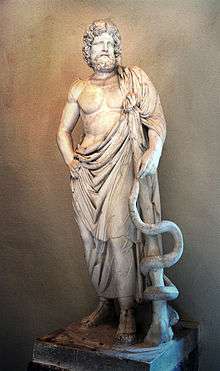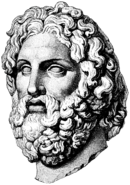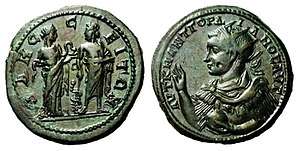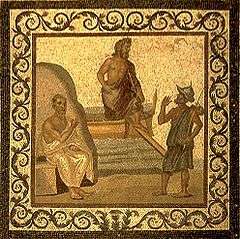Asclepius
Asclepius (/æsˈkliːpiəs/; Greek: Ἀσκληπιός Asklēpiós [asklɛːpiós]; Latin: Aesculapius) or Hepius[1] is a hero and god of medicine in ancient Greek religion and mythology. He is the son of Apollo and Coronis, or Arsinoe, or of Apollo alone. Asclepius represents the healing aspect of the medical arts; his daughters are Hygieia ("Hygiene", the goddess of cleanliness), Iaso (the goddess of recuperation from illness), Aceso (the goddess of the healing process), Aegle (the goddess of good health), Panacea (the goddess of universal remedy), and several sons. He was associated with the Roman/Etruscan god Vediovis and the Egyptian Imhotep.[2] He shared with Apollo the epithet Paean ("the Healer").[3] The rod of Asclepius, a snake-entwined staff, remains a symbol of medicine today. Those physicians and attendants who served this god were known as the Therapeutae of Asclepius.
| Asclepius | |
|---|---|
God of medicine, healing, rejuvenation and physicians | |
 Asclepius with his serpent-entwined staff, Archaeological Museum of Epidaurus | |
| Symbol | Serpent-entwined staff |
| Personal information | |
| Parents | Apollo and Coronis |
| Siblings | half-siblings of Asclepius |
| Consort | Epione |
| Children |
|
| Roman equivalent | Vejovis |
| Greek deities series |
|---|
| Other deities |
Etymology
The etymology of the name is unknown. In his revised version of Frisk's Griechisches etymologisches Wörterbuch (Greek Etymological Dictionary), R.S.P. Beekes gives this summary of the different attempts:
- "H. Grégoire (with R. Goossens and M. Mathieu) in Asklépios, Apollon Smintheus et Rudra 1949 (Mém. Acad. Roy. de Belgique. Cl. d. lettres. 2. sér. 45), explains the name as 'the mole-hero', connecting σκάλοψ, ἀσπάλαξ 'mole' and refers to the resemblance of the Tholos in Epidauros and the building of a mole. (Thus Puhvel, Comp. Mythol. 1987, 135.) But the variants of Asklepios and those of the word for 'mole' do not agree.
- The name is typical for Pre-Greek words; apart from minor variations (β for π, αλ(α) for λα) we find α/αι (a well known variation; Fur. 335–339) followed by -γλαπ- or -σκλαπ-/-σχλαπ/β-, i.e. a voiced velar (without -σ-) or a voiceless velar (or an aspirated one: we know that there was no distinction between the three in the substr. language) with a -σ-. I think that the -σ- renders an original affricate, which (prob. as δ) was lost before the -γ- (in Greek the group -σγ- is rare, and certainly before another consonant).
- Szemerényi's etymology (JHS 94, 1974, 155) from Hitt. assula(a)- 'well-being' and piya- 'give' cannot be correct, as it does not explain the velar."[4]
Mythology

Birth
Asclepius was the son of Apollo and, according to the earliest accounts, a mortal woman named Coronis.[6][7] When she displayed infidelity by sleeping with a mortal named Ischys, Apollo came to know this with his prophetic powers and killed Ischys. Coronis was killed by Artemis for being unfaithful to Apollo and was laid out on a funeral pyre to be consumed, but Apollo rescued the child by cutting him from Coronis's womb.[8]
According to Delphian tradition, Asclepius was born in the temple of Apollo, with Lachesis acting as a midwife and Apollo relieving the pains of Coronis. Apollo named the child after Coronis' nickname, Aegle.[9]
Phoenician tradition maintains that Asclepius was born of Apollo without any woman involved.[10]
According to the Roman version, Apollo, having learned about Coronis' betrayal with the mortal Ischys through his raven, killed her with his arrows. Before breathing her last, she revealed to Apollo that she was pregnant with his child. He repented his actions and unsuccessfully tried to save her. At last, he removed their son safely from her belly before she was consumed by the fire.[11]
In yet another version, Coronis who was already pregnant with Apollo's child, had to accompany her father to Peloponnesos. She had kept her pregnancy hidden from her father. In Epidaurus, she bore a son and exposed him on a mountain called Nipple. The child was given milk by one of the goats that pastured about the mountain, and was guarded by the watch-dog of the herd. Aresthanas, the owner of goats and the guard dogs found the child. As he came near, he saw lightning that flashed from the child, and thinking of it to be a sign of divine, he left the child alone. Asclepius was later taken by Apollo.[12]
Education and adventures
Apollo named the rescued baby Asclepius and reared him for a while and taught him many things about medicine.[13] However, Asclepius had his formal education under the centaur Chiron who instructed him in the art of medicine.[14]
It is said that in return for some kindness rendered by Asclepius, a snake licked Asclepius's ears clean and taught him secret knowledge (to the Greeks snakes were sacred beings of wisdom, healing, and resurrection). Asclepius bore a rod wreathed with a snake, which became associated with healing. Other version states that when Asclepius (or in another myth Polyidus) was commanded to restore the life of Glaucus , he was confined in a secret prison. While pondering on what he should do, a snake crept near his staff. Lost in his thoughts, Asclepius unknowingly killed it by hitting it again and again with his staff. Later, another snake came there with a herb in its mouth, and placed it on the head of dead snake, which soon came back to life. Seeing this, Asclepius used the same herb, which brought Glaucus back.[15] A species of non-venomous pan-Mediterranean serpent, the Aesculapian snake (Zamenis longissimus) is named for the god.
He was originally called Hepius but received his popular name of Asclepius after he cured Ascles, ruler of Epidaurus who suffered an incurable ailment in his eyes.[1] Asclepius became so proficient as a healer that he surpassed both Chiron and his father, Apollo. Asclepius was therefore able to evade death and to bring others back to life from the brink of death and beyond. This caused an influx of human beings and Zeus resorted to killing him to maintain balance in the numbers of the human population.
At some point, Asclepius was among those who took part in the Calydonian Boar hunt.
Marriage and family

Asclepius was married to Epione, with whom he had five daughters: Hygieia, Panacea, Aceso, Iaso, and Aegle,[16][17] and three sons: Machaon, Podaleirios and Telesphoros. He also sired a son, Aratus, with Aristodama.[17][18][19][20][21][22][23]
Death and resurrection as a God
Asclepius once started bringing back to life the dead people like Tyndareus, Capaneus, Glaucus, Hymenaeus, Lycurgus and others.[24] Others say he brought Hippolytus back from the dead on Artemis' request, and accepted gold for it.[25][26][27] It is the only mention of Asclepius resurrecting the dead. In all other accounts he is said to use his skills simply as a physician.
However, Hades accused Asclepius for stealing his subjects and complained to his brother Zeus about it.[28] According to others, Zeus was afraid that Asclepius would teach the art of resurrection to other humans as well.[29] So he killed Asclepius with his thunderbolt. This angered Apollo who in turn killed the Cyclopes who made the thunderbolts for Zeus.[30] For this act, Zeus banished Apollo from Olympus[31] and commanded him to serve Admetus, King of Thessaly for a year.[32] After Asclepius's death, Zeus placed his body among the stars as the constellation Ophiuchus ("the Serpent Holder").[33]
Later, however, upon Apollo's request, Zeus resurrected Asclepius as a god and gave him a place on Olympus.[34][35]
Sacred places and practices

The most ancient and the most prominent asclepeion (or healing temple) according to the geographer of the 1st century BC, Strabo, was situated in Trikala.[36] The 1st century AD Pool of Bethesda, described in the Gospel of John, chapter 5, was found by archaeologists in 1964 to be part of an asclepeion.[37][38] One of the most famous temples of Asclepius was at Epidaurus in north-eastern Peloponnese, dated to the fourth century BC.[39] Another famous asclepeion was built approximately a century later on the island of Kos,[39] where Hippocrates, the legendary "father of medicine", may have begun his career. Other asclepieia were situated in Gortys (in Arcadia), and Pergamum in Asia.
From the fifth century BC onwards,[40] the cult of Asclepius grew very popular and pilgrims flocked to his healing temples (Asclepieia) to be cured of their ills. Ritual purification would be followed by offerings or sacrifices to the god (according to means), and the supplicant would then spend the night in the holiest part of the sanctuary – the abaton (or adyton). Any dreams or visions would be reported to a priest who would prescribe the appropriate therapy by a process of interpretation.[41] Some healing temples also used sacred dogs to lick the wounds of sick petitioners.[42] In honor of Asclepius, a particular type of non-venomous snake was often used in healing rituals, and these snakes — the Aesculapian Snakes — slithered around freely on the floor in dormitories where the sick and injured slept. These snakes were introduced at the founding of each new temple of Asclepius throughout the classical world.
The original Hippocratic Oath began with the invocation "I swear by Apollo the Physician and by Asclepius and by Hygieia and Panacea and by all the gods ...".[42]
Some later religious movements claimed links to Asclepius. In the 2nd century AD the controversial miracle-worker Alexander claimed that his god Glycon, a snake with a "head of linen"[43] was an incarnation of Asclepius. The Greek language rhetorician and satirist Lucian produced the work Alexander the False Prophet to denounce the swindler for future generations. He described Alexander as having a character "made up of lying, trickery, perjury, and malice; [it was] facile, audacious, venturesome, diligent in the execution of its schemes, plausible, convincing, masking as good, and wearing an appearance absolutely opposite to its purpose."[43] In Rome, the College of Aesculapius and Hygia was an association (collegium) that served as a burial society and dining club that also participated in the Imperial cult.
The botanical genus Asclepias (commonly known as milkweed) is named after him and includes the medicinal plant A. tuberosa or "Pleurisy root".
Asclepius was depicted on the reverse of the Greek 10,000 drachmas banknote of 1995–2001.[44]
See also
References
- John Tzetzes. Chiliades, 10.49 lines 712–714
- Pinch, Geraldine (1 January 2002). Handbook of Egyptian Mythology. ABC-CLIO. ISBN 9781576072424.
- Mitchell-Boyask, p. 141
- Greek etymology database (online source requires login and is located at iedo.brillonline.nl Archived 29 September 2014 at the Wayback Machine). Originally: "Archived copy". Archived from the original on 28 September 2007. Retrieved 11 April 2009.CS1 maint: archived copy as title (link) Also in: R.S.P. Beekes, Etymological Dictionary of Greek, Brill, 2009, p. 151.
- R.S.P. Beekes, Etymological Dictionary of Greek, Brill, 2009, p. xxv.
- Homeric Hymn 16
- Diodorus Siculus, Library of History 5. 74. 6
- Pindar Pythian Ode 3.5
- Isyllus, Hymn to Asclepius
- Pausanias, Description of Ancient Greece 7.23.7
- Ovid, Metamorphoses 2. 620
- Pausanias, Description of Greece 2. 26. 1 - 7
- Diodorus Siculus, Library of History 5. 64. 6
- Pindar, Pythian Ode 3.5ff (trans. Conway) (Greek lyric 5th century BC)
- Pseudo-Hyginus, Astronomica 2. 14
- Greek Lyric V Anonymous, Fragments 939 (Inscription from Erythrai) (trans. Campbell)
- Suidas s.v. Epione (trans. Suda On Line)
- Pausanias, Description of Greece 2.29.1 (trans. Jones)
- Homer, Iliad 4.193 and 217ff (trans. Lattimore)
- Homer, Iliad 11.518ff (trans. Lattimore)
- Homer, Iliad 2.730ff (trans. Lattimore)
- Lycophron, Alexandra 1047ff (trans. Mair)
- Diodorus Siculus, Library of History 4.71.3 (trans. Oldfather)
- Stesichorus, Fragment 147 (from Sextus Empricicus, Against the Professors)
- Philodemus, On Piety (trans. Campbell, Vol. Greek Lyric IV Stesichorus Frag. 147 and Cinesias Frag. 774)
- Plato, Republic 408b
- Pindar, Pythian Ode 3
- Diodorus Siculus, Library of History 4. 71. 3
- Pseudo-Apollodorus, Bibliotheca 3. 121
- Apollodorus, Bibliotheca 3.121 (trans. Aldrich)
- Apollonius Rhodius, Argonautica 4.610ff (trans. Rieu)
- Diodorus Siculus, Library of History 4. 71. 3
- Hyginus, Astronomica 2.14
- Ovid, Fasti 6. 735
- Cicero, De Natura Deorum 2. 24
- "Asclepeion of ancient Trikki | Municipality of Trikala". Municipality of Trikala.
- An archaeological diagram of the layout – the diagram displayed at the location itself – is visible at this link Archived 4 June 2011 at the Wayback Machine.
- Jerome Murphy-O'Connor, The Holy Land, (2008), page 29
- Edelstein, Ludwig and Emma Edelstein. Asclepius: a Collection and Interpretation of the Testimonies. Vol. 2. Baltimore: Johns Hopkins Press, 1998. p. 243
- Wickkiser, Bronwen. Asklepios, Medicine, and the Politics of Healing in Fifth-century Greece: Between Craft and Cult. Johns Hopkins Press, 2008. p. 106
- Sigerist 1987, pp. 63ff
- Farnell, Chapter 10, "The Cult of Asklepios" (pp. 234–279)
- Lucian, Alexander the False Prophet (trans A.M. Harmon) (Cambridge: Loeb Classical Library, 1936), Lucian, vol IV. Accessible online at http://www.tertullian.org/rpearse/lucian/lucian_alexander.htm
- Bank of Greece Archived 28 June 2015 at the Wayback Machine. Drachma Banknotes Archived 11 July 2010 at the Wayback Machine. 10,000 drachma note (pdf) Archived 11 June 2011 at the Wayback Machine – Retrieved 26 July 2010.
Sources
- Edelstein, Ludwig and Emma Edelstein. Asclepius: Collection and Interpretation of the Testimonies. JHU Press, 1998.
- von Ehrenheim, Hedvig. Greek Incubation Rituals in Classical and Hellenistic Times. Kernos. Supplément, 29. Liège: Presses Universitaires de Liège, 2015.
- Farnell, Lewis Richard. Greek Hero Cults and Ideas of Immortality, (Oxford Clarendon Press,1921).
- Grimal, Pierre, The Dictionary of Classical Mythology, Wiley-Blackwell, 1996, ISBN 978-0-631-20102-1. "Asclepius" pp. 62–63
- Hart, Gerald D. MD. Asclepius: The God of Medicine (Royal Society of Medicine Press, 2000)
- Kool, S. "The Soother of Evil Pains: Asclepius and Freud." Akroterion 60, 2015, pp. 13–32.
- LiDonnici, Lynn R. The Epidaurian Miracle Inscriptions: Text, Translation, and Commentary. Atlanta: Scholars, 1995.
- Mitchell-Boyask, Robin, Plague and the Athenian Imagination: Drama, History and the Cult of Asclepius, Cambridge University Press, 2008, ISBN 978-0-521-87345-1.
- Oberhelman, Steven M. (ed.), Dreams, Healing, and Medicine in Greece: From Antiquity to the Present. Farnham; Burlington, VT: Ashgate, 2013.
- Renberg, Gil H. "Public and Private Places of Worship in the Cult of Asclepius at Rome". Memoirs of the American Academy in Rome, 51/52, 2006, pp. 87–172.
- Riethmüller, Jürgen W. Asklepios : Heiligtümer und Kulte, Heidelberg, Verlag Archäologie und Geschichte, 2005, ISBN 3-935289-30-8
- Sigerist, Henry E. (1987). A History of Medicine Volume 2: Early Greek, Hindu, and Persian Medicine (1st ed.). New York: Oxford University Press. ISBN 978-0-19-505079-0.CS1 maint: ref=harv (link)
- Wickkiser, Bronwen. Asklepios, Medicine, and the Politics of Healing in Fifth-century Greece: Between Craft and Cult. JHU Press, 2008.
External links
- Warburg Institute Iconographic Database (c. 100 images of Aesculapius)